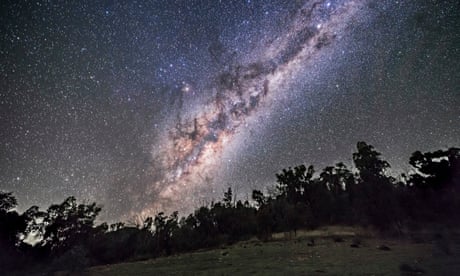- by foxnews
- 23 May 2025
Trio of meteor showers set to dazzle in Australia’s skies - here’s when and where to look
Trio of meteor showers set to dazzle in Australia’s skies - here’s when and where to look
- by theguardian
- 27 Jul 2022
- in news

The night sky is set to be illuminated by a trio of meteor showers - the Piscis Austrinids, the Southern Delta Aquariids and the Alpha Capricornids - that will peak later this week.
The meteor showers coincide with the dark night sky of a new moon on 29 July, providing ideal viewing conditions.
The Piscis Austrinids meteor shower is expected to peak first, on 28 July, while the Southern Delta Aquariids and the Alpha Capricornids will peak on 30 July. The peak period lasts about 48 hours.
The Southern Delta Aquariids will have the most meteors, with up to 20 an hour at the peak, according to Prof Orsola De Marco from Macquarie University.
The Piscis Austrinids and the Alpha Capricornids have a comparatively low shower rate, of five and four meteors an hour respectively, De Marco said.
Meteor showers occur when cosmic debris enters the Earth's atmosphere. The source of this debris is often from comets, which have long orbits around the sun.
"Like my cat, comets shed bits," De Marco said. "These bits remain pretty much in orbit - so imagine a very elongated orbit that's full of little bits."
When the Earth crosses the path of a comet's orbit, it encounters this debris. "It's like when you are driving your car through a cloud of insects - you get them all in your windshield," De Marco said.
The debris burns up as it enters Earth's atmosphere, resulting in dazzling displays across the sky.
The Southern Delta Aquariids come from the comet 96P/Machholz, while the parent body of the Alpha Capricornids is the comet 169P/NEAT. Astronomers have not yet found where the Piscis Austrinids originate from.
A meteor shower is named after the nearest constellation to the radiant, the point in the sky which the shower appears to come from. The radiant of the Southern Delta Aquariids, for example, is close to the star Delta Aquarii, in the constellation Aquarius.
While the meteor showers are visible from everywhere on Earth, there will be better viewing from the southern hemisphere.
Piscis Austrinids: peaks 28 July
If you're on the east coast of Australia, the Piscis Austrinids will rise around 8pm to the south-east, travelling closer to due east by 11pm, De Marco said. "Look towards the east, about 45 degrees up - about halfway between the horizon and above your head."
Southern Delta Aquariids: peaks 30 July
The Southern Delta Aquariids will be visible around 11pm, to the east-northeast and 45 degrees upwards from the horizon, De Marco said. This shower has the quickest meteors of the three peaking this week.
Alpha Capricornids: peaks 30 July
The Alpha Capricornids are "relatively bright and will have some fireballs," De Marco said. Fireballs are very bright meteors - at least as bright as Venus in the morning or evening sky.
At about 11pm on 30 July, the shower will be visible to the north-northeast, about 65 degrees up from the horizon.
Perseids to dazzle in August
Another ongoing meteor shower is the dazzling Perseids, which is expected to peak on 13 August. At its peak, there will be more than 100 meteors an hour, De Marco said.
The radiant of this meteor shower is very close to the horizon, she said.
"You're going to see [meteors] going upwards from the north horizon. They're going to look like they are rising as opposed to falling."
In Australia, the best viewing will be towards the north at 5am on 13 August.
For people who want to plan their viewing experience in more detail, the open-source software Stellarium can model the night sky in 3D.
- by foxnews
- descember 09, 2016
United Airlines flight returns to Hawaii after concerning message found on bathroom mirror; FBI investigating
United Airlines Flight 1169 to Los Angeles returned to Hawaii after a "potential security concern" aboard the plane. The FBI and police are investigating.
read more


